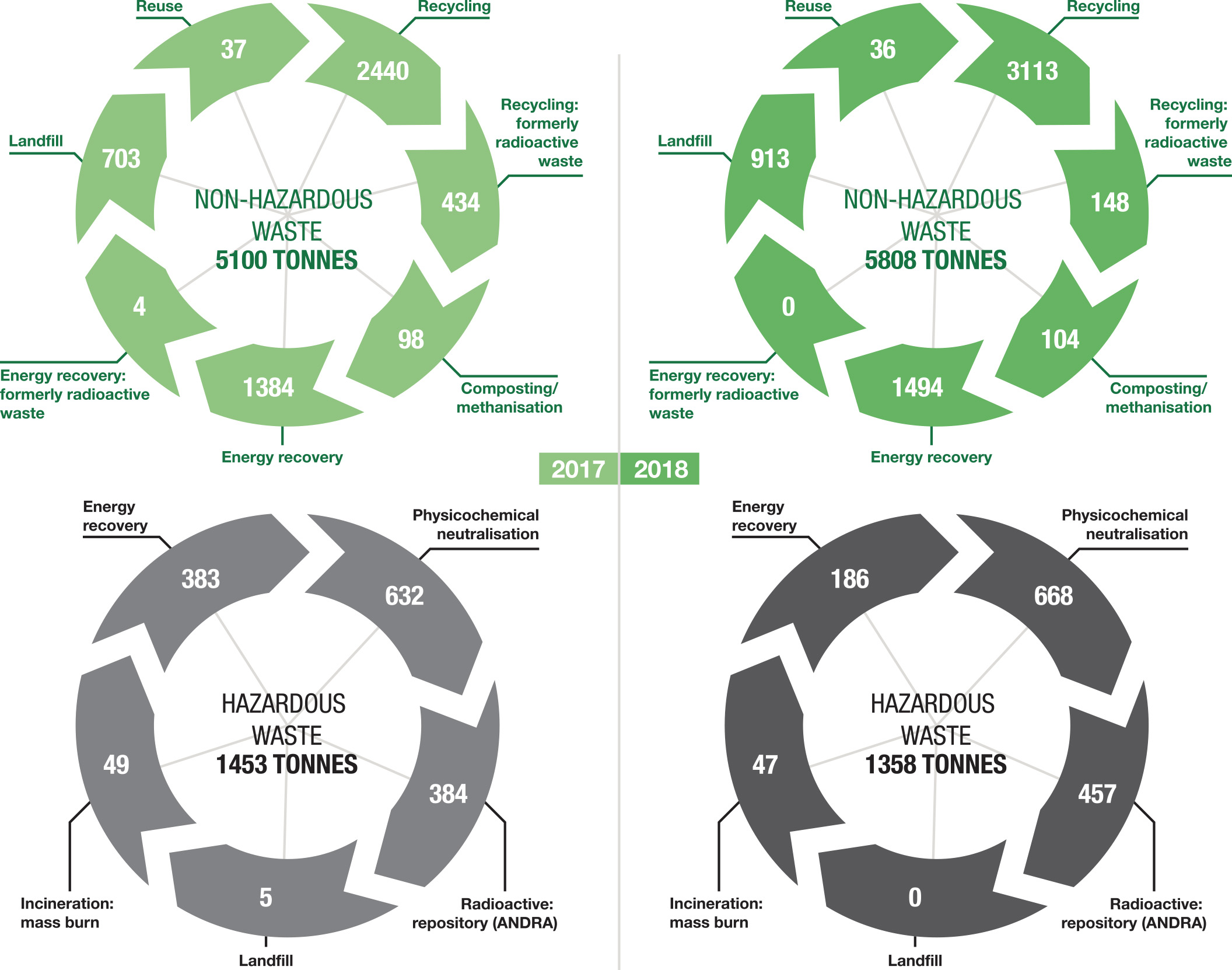
|
|
|
CERN'S WASTE CATEGORISED BY ELIMINATION PATHWAY. Quantities of waste and information on elimination pathways for radioactive waste are based on CERN data. Data on elimination pathways for all other categories come from the companies engaged by CERN to eliminate the waste. |
CERN’s waste management strategy is based on European, French and Swiss regulatory frameworks. It aims to ensure that waste is managed safely and appropriately, in ways that pose no unacceptable risk to people and the environment.
WASTE AT CERN
CERN eliminates 100% of its waste. In 2018, the total amount of conventional, non-hazardous waste eliminated was 5808 tonnes consisting of industrial waste, electrical and electronic equipment (subject to monitoring according to the Swiss regulation OMod), aluminium, glass and PET, paper and cardboard, biodegradable waste, coffee capsules and household waste. CERN had a recycling rate of 56% for non-hazardous waste. 81% of the Laboratory’s total eliminated waste is non-hazardous. Radioactive waste elimination is managed through the tripartite agreement on radiation protection and radiation safety between CERN, France and Switzerland. It is overseen by the respective national authorities ASN and OFSP.
The Laboratory’s hazardous waste consists of chemicals and their containers, any type of material contaminated by hazardous substances, printer cartridges and light bulbs. Radioactive waste is also categorised as hazardous. CERN has specific procedures in place for the safe storage, removal and disposal of both conventional hazardous waste and radioactive waste.
The data provided here do not include waste generated and eliminated by external contractors active on CERN’s premises, or end-of-life equipment directly picked up by or sent back to the supplier. These will be included in a future report.
RADIOACTIVE WASTE
CERN’s scientific activities produce radioactive waste with low-level activity. This consists mainly of large metallic components, cables and ventilation filters, and also includes waste from operations, such as gloves, overalls and papers. These materials are collected mainly during periods of maintenance and consolidation of research facilities. The dismantling of installations can also generate activated concrete and soil from the immediate vicinity of CERN’s underground infrastructures. CERN reuses activated material as far as possible, in particular as shielding.
CERN does not produce any highly radioactive waste. Most radioactive waste produced at CERN is only slightly activated, and falls into three categories: materials with extremely low activity; materials with very low activity; and materials of low to medium activity. In 2017 and 2018, CERN generated 524 and 327 tonnes of radioactive waste respectively. This is temporarily stored in a dedicated secure storage area. A specific elimination process is defined through the tripartite agreement between CERN, France and Switzerland on radiation protection and radiation safety.
Managing non-radioactive waste
The Laboratory has a centralised waste management system that handles all non-radioactive waste collection and transportation for safe and appropriate disposal. Hazardous waste is sent to a temporary buffer zone and is collected weekly. Metallic and electronic waste are sorted and sold. CERN implements waste reduction projects and awareness campaigns. CERN’s main objective for waste management is to increase the current recycling rate.
CERN maintains a waste inventory that lists all waste leaving CERN via the centralised management system. This helps to ensure the traceability of waste pathways.
Managing radioactive waste

Radioactive waste: sorted and compressed.(Image: CERN)
Radioactive waste management has always been a high priority for CERN. Today it is handled in the framework of the tripartite agreement on radiation protection and radiation safety. The process begins with the initial conception of a facility or experiment, and concludes with disposal of radioactive waste to the final repositories. The generation of radioactive waste is minimised by avoiding, recycling and reusing activated material.
CERN’s radioactive waste management is performed by a specialised radiation protection team. The team receives waste regularly, with more being received during maintenance shutdowns. After receiving and categorising waste, the team treats it in a dedicated state-of-the-art facility where it is dismantled, sorted, reduced in volume and packaged according to elimination pathway criteria.
CERN’s radioactive waste is eliminated in accordance with the tripartite agreement through existing pathways in the Host States with a view to optimising the elimination while respecting the principle of a fair share between France and Switzerland. In Switzerland, CERN uses the possibility of free-release, whereby formerly radioactive waste is released as traceable non-hazardous waste following a demonstration that it no longer qualifies as radioactive according to the Swiss ordinance for radiation protection, ORaP. CERN annually reports data on radioactive waste to the Host State authorities. In 2018, CERN produced 327 tonnes of radioactive waste and disposed of 605 tonnes, 457 of which were sent to a final repository in France (http://andra.fr). In 2017, 438 tonnes were classified as no longer radioactive and released for clearance in Switzerland. In 2018, the figure was 148 tonnes.
IN FOCUS
Pioneering a precautionary approach to future facilities
Activation of material is an unavoidable issue for any facility working with high-energy particle beams. Optimising fundamental parameters, such as the chemical composition of components, is one way to reduce material activation. However, it is not a simple task. In order to reduce material activation, and thus reduce radioactive waste, CERN has developed a software package called ActiWiz. By providing a simple and intuitive way to analyse materials, ActiWiz helps decision makers choose those materials least susceptible to activation. Since the first version of ActiWiz, the code has become very versatile, allowing for detailed calculation of nuclide inventories along with associated risks and mitigation measures. ActiWiz has been adopted by several other research laboratories.
Learn more
Questions regarding this report may be addressed to Environment.report@cern.ch.
